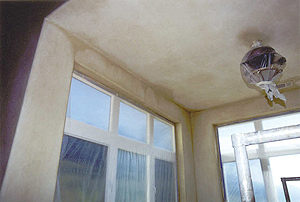
More tips on using lime wash
Mike Hoppe, co-owner of Faux Masters Studio, has devised his own interior technique to replicate the look found on the exteriors of weathered Tuscan villas.
but also works in the field with the family-run Hoppe Brothers & Sons, want Old World lime wash on the interior walls of their modern California homes.
Typically, he says, he’ll use three different colors of lime wash or paint to get the desired effect. He applies the first coat over regular white latex house paint with the aid of a piece of wadded cheesecloth that’s about 6 or 7 feet long. “The first coat is applied in a positive fashion by dipping the cheesecloth in the lime wash, wringing it to a dampened state and randomly pouncing it on the wall — almost like we were sponging in a quick, up-and-down jitterbug fashion — to make it look ‘consistently inconsistent’ all over. You want even coverage but you don’t want the look of rolled paint.”
This first coat, which is often a light ocher color, looks mottled and translucent the first time around the room, he says. But that’s just the beginning.
 Next, he wets the wall with a garden sprayer filled with water and uses a second sprayer to apply a watered-down version of a deeper-toned color. “Putting water on the wall before applying the second coat gives you the needed working time,” he says, “more time to massage it in. But it’s tricky now because the wall is dark [one of lime’s attributes when wet] when you’re putting on the second layer.” Hoppe says he doesn’t believe in adding extenders to the lime paint to make it dry slower because extenders take away its strength. Next, he wets the wall with a garden sprayer filled with water and uses a second sprayer to apply a watered-down version of a deeper-toned color. “Putting water on the wall before applying the second coat gives you the needed working time,” he says, “more time to massage it in. But it’s tricky now because the wall is dark [one of lime’s attributes when wet] when you’re putting on the second layer.” Hoppe says he doesn’t believe in adding extenders to the lime paint to make it dry slower because extenders take away its strength.
Concentrating on the corners and baseboards, he uses cheesecloth or disposable brushes to apply the second color that has “more gray, raw umber tones to it.” This coating will produce a shadow effect or simulate dirt stains or water stains that have accumulated in corners, crevices and crannies, Hoppe explains.
He adds that he typically does a partial third coat — again with cheesecloth — “going back over the wall with a deeper value of the first color so some areas are more intense,” he explains. “You chase the lime wash with a cheesecloth so you don’t have unpleasant runs or drips, and you massage the coating into the wall. You layer it up and you start to build depth that you don’t get in a single application. When you’re done, you can still see some of the white below. It’s translucent.” This final step, he advises, is not for the beginner but rather for someone with an artistic touch.
Surprisingly, he says, this whole process goes very fast with an experienced crew, although it takes more time than if you were just brushing it on. “Lime wash is murder on your tools,” Hoppe points out. “There’s no reason to use an expensive brush.”
Hoppe, who says he’s a “chemist wanna-be” at heart, teaches how to apply lime wash and paint in his Venetian plaster class. “I started playing around with lime paint in 1998-99 and found things I liked and didn’t like. Nobody told me this is how you do it; I just didn’t like the way it looked brushed on,” he says. “People are always asking me ‘how come yours looks so different than ours?’ It’s all in the technique.
Hoppe shares a lifetime of contracting knowledge through Faux Masters Studios. “We take the more practical approach. Some of the finishes being taught out there are less in demand. Lime wash, however, is growing in popularity, not just among the elite but also among average homeowners. You can earn a living if you can do this finish.”
Faux Masters Studio, located in Yorba Linda, Calif., is a product distributor and instructional studio for decorative painting. 
|

